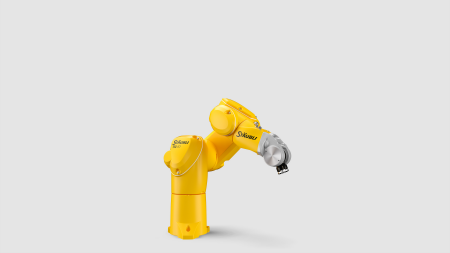Erfolgsgeschichte
Hochkomplexe Präzisionsmontage von Sensormodulen
Die Herstellung von Sensormodulen für Dieselmotoren erfordert hochentwickelte Automatisierungslösungen – und das bei stark miniaturisierten Komponenten. Mit hochpräzisen Robotern und einer intelligenten Servicestrategie begegnet Bosch im Werk Bamberg dieser Herausforderung.
KUNDENVORTEILE
- Prozesssichere Automation anspruchsvollster Montageschritte
- Intelligentes Wartungskonzept
- Hochpräzise Roboter mit überlegener Antriebstechnik
- Sichere Einhaltung ultrakurzer Taktzeiten
- Durchgängige Dokumentation und Rückverfolgbarkeit
AUFGABE
Montage von Sensormodulen
Anspruchsvolle Montageprozesse von Kleinstbauteilen bestimmen bei Bosch Bamberg die Herstellung von Common-Rail-Injektoren, -Düsen und -Sensoren für Einspritzsysteme von Dieselmotoren. Zu den Kernprozessen der Fertigung gehört auch die Montage von Sensormodulen. Dieser komplexe Prozess stellt höchste Anforderungen an die Robotik und macht eine ganz besondere Servicestrategie erforderlich.
Bereits der erste Blick auf den Rundschalttisch, auf dessen Stationen die eigentliche Montage samt Qualitätssicherung stattfindet, verdeutlicht die Komplexität dieser Zelle. Auf engstem Raum sind hier fünf Stäubli Roboter und 18 Bildverarbeitungssysteme installiert, drei davon auf NC-Achsen, die ein Verfahren der Kameras ermöglichen.
Die Bestückung der Montagenester des Rundschalttisches mit den winzigen Bauteilen übernehmen schnelle und präzise Stäubli TX2 Sechsachsroboter. Die Bereitstellung der Teile erfolgt über automatische Zuführungen. Kameras übermitteln die exakten Greifpositionen an die Roboter. Auch das präzise Ablegen der Bauteile in den Nestern des Rundschaltisches erfolgt kameraüberwacht. Damit ist bereits die Vorbestückung des Rundtisches im Sinne einer Null-Fehler-Montage lückenlos überwacht und dokumentiert.
LÖSUNG
Extrem-Anforderung: Wiederholgenauigkeit liegt unter 10 µm
Alle Montageschritte stellen hohe Ansprüche an die Automation, doch die letzte Station am Rundschalttisch verlangte nach einer besonderen Lösung. Über die fertig montierte Sensoreinheit ist das Gehäuse mit seinem Durchmesser von kleiner zehn Millimetern zu fügen. Dabei müssen die 0,6 mm dünnen Kontaktierungs-Pins durch die Öffnungen im Gehäuse geführt werden. Die dabei vom Roboter geforderte Präzision liegt unter 10 µm.
Damit hätte sich diese Applikation für die Robotik eigentlich erledigt, denn dieser Wert wird von keinem Serienroboter erreicht, noch nicht einmal vom hochpräzisen TX2-40, dem Stäubli eine Wiederholgenauigkeit von +- 20 µm attestiert. Doch die erstklassige JCS-Antriebstechnologie des Stäubli TX2 Roboters erlaubte die Steigerung der Präzision durch gezieltes „Feintuning“.
Speziell angepasstes Wartungskonzept
Die so erreichte, extreme Präzision hat auch zur Folge, dass normale Servicekonzepte hier nicht greifen. Durch den üblichen jährlichen Service oder bei einem ungeplanten Eingriff würde die Präzision verloren gehen. Der Roboter müsste ganz neu eingemessen werden – was nur bei Bosch auf einer speziellen Messanlage geschehen kann.
Um unter diesen Umständen im Servicefall schnell reagieren zu können, haben Stäubli und Bosch gemeinschaftlich ein spezielles individuelles Wartungskonzept entwickelt. Bosch hält hier einen baugleichen Roboter vor, der zuerst bei Stäubli gewartet wird. Anschließend werden die Getriebe exakt eingestellt und mittels Lasertechnik vermessen. Dann wird der Roboter bei Bosch präzisionsoptimiert. Er ist also jederzeit sofort einsatzbereit.
- teaser
- teaser
- teaser
KUNDENNUTZEN
Prozesssichere Montage auf kompaktem Raum
Nach einem exakt festgelegten Wartungsintervall werden die beiden Roboter im Wechsel getauscht. Das schafft die Voraussetzung für eine unterbrechungsfreie und prozesssichere Qualitätsproduktion.
Zu den weiteren Merkmalen der Sensormontagestation gehören eine außerordentlich kompakte Bauweise und die ESD-gerechte Ausführung aller Komponenten einschließlich der Roboter: Schließlich werden hier elektronische Bauteile montiert, die mit kleinen Spannungen und Strömen arbeiten und entsprechend empfindlich sind.
Keinesfalls ungewöhnlich ist der Einsatz von Stäubli Robotern im Bosch-Werk Bamberg. Hier kommen grundsätzlich Stäubli Roboter zum Einsatz. Das bewährt sich auch bei dieser ungewöhnlichen Anlage, die präziser arbeitet als ein Präzisions-Roboter es eigentlich kann. Mit dieser Montageanlage haben Bosch und Stäubli Neuland beschritten und bewiesen, wie sich in gemeinschaftlicher Zusammenarbeit Grenzen des technisch Machbaren verschieben lassen. Das Resultat dieser Zusammenarbeit: Auch unter den extremen Präzisions-Anforderungen läuft die Anlage stabil und hochproduktiv mit extrem geringer Fehlerrate.

